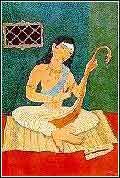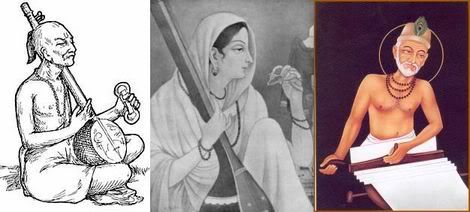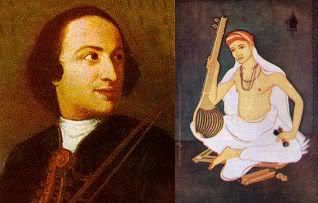Music in tune with the Divine
Vasudev Murthy
First Published in the Deccan Herald on August 30, 2005
Thyagaraja's inspired dialogue with a benevolent God, via music, is made more believable because of what we know of his simple lifestyle.
Just as the music of Tartini and Paganini was believed to be inspired by the Devil, there are other kinds of music that have strong religious connotations; melody, harmony and rhythm have been used to persuade invisible powers to shower grace and favours on a person or persons. Martial music is perhaps an exception. However, even military tunes have a purpose - to enthuse, to motivate and to convince soldiers or a nation that righteousness was on their side and the forces of darkness would shortly be annihilated.
Indian music has been blessed in many ways. Apart from the rigour of a grammar and taxonomy in both major streams of classical music via Sarangadeva and Venkatamakhi, the religious traditions of the country have sparked musical creativity to the extreme. Most examples are well known. Surdas of the Bhakti movement found inspiration in the life of Krishna to burst forth into song. Mira Bai was obsessed with Krishna and created bhajans spontaneously. She and Kabirdas were major figures of the Bhakti movement. Except perhaps for the period of Aurangzeb who frowned on it, music and religious dedication have been respected in India for centuries, and virtuosity has been admired rather than looked upon suspiciously.
A lesser known example of the tight bond between classical music and religion has been in the Sikh tradition. Guru Arjan Dev, the Fifth Guru, set the entire Guru Granth Sahib to about thirty different classical raagas. Knowing how the mind reacts to various raagas, he took extreme care while choosing them.
The lessons of the Granth Sahib thus prescribe correct behaviour and clean living through music; this is not imagination -- the feeling of elevation and the desire to do good does take shape if you listen to well sung shabads in certain raagas - try Ramkali, for instance.
Guru Arjan Dev was obviously gifted and understood group psychology and the power of music in shaping religious sentiment. This effect is seen elsewhere in choir music, bhajans and qawwalis alike, where the musicians and the audience collectively enter some kind of a rarified collective mental state for a period of time. This mass demonstration of piety via music is intended to inform a compassionate entity (God) of their devotion to Him.
And not too long ago, while Paganini was being looked at jealously in Italy, Thyagaraja (1767 -- 1848) performed musical miracles and composed hundreds of kritis across the entire complex spectrum of Carnatic raagas. Whether he was extremely pious and was consumed by the need to see Rama and therefore composed so many kritis or whether he was musically gifted anyway and found bhakti to Rama as a perfect channel to vent the music is a pointless debate. An obsession with his concept of the Supreme combined with musical genius gave us expressions of immense musical creativity which are unlikely to be ever surpassed. Thyagaraja was lucky - and so were we - that the social environment he lived in - Thanjavur in this instance - respected music and he was given recognition while he lived. He had exalted company - Muthuswami Dikshitar and Shyama Sastry lived in the same area at about the same time - and was sufficiently motivated to enhance his genius.
Some people are tone deaf while others are believed to have a perfect ear for detecting variations in music. But generally, the range of audible frequencies means that our musical experience is limited by the construction of the ear and the etrainingf that our neurons receive over years - and occasionally genes. In our tradition, we also speak of anahat - the music that cannot be heard except by the spiritually exalted. We would like to believe that many geniuses derive inspiration from an unknown benign source because the extent of their musical experience is beyond the normal and they can perhaps access the anahat due to 'spiritual purity' or, at any rate, some peculiarity.
A Thyagaraja Composition
A Muthuswami Diskshitar Composition (Veena)
A Shyama Sastry Composition (Violin)
Thyagaraja is no longer available. His inspired dialogue with a benevolent God, via music, is made that much more believable because of what we know of his simple lifestyle and true rejection of the material world. It is fashionable today for modern musicians to refer to their 'divine' experiences and to mutter some intelligible shlokas, while having a keen eye on economic benefits and possible felicitations and awards in the pipeline. It is rare to find 'inner peace' in most of today's concerts, though one might find technical perfection and even a pleasing experience.
What set the music of - for instance -the late MS Subbalakshmi, Nikhil Bannerjee and Pannalal Ghosh apart was a definite element of inner contentment in their music and a distinct lack of interest in playing to the gallery. They communed with an invisible world via music while they were alive. Their music leaves clues to us about the Great Beyond.
Tartini and Thyagaraja. One spoke to the Devil and the other to God. And music was the language they both chose.
--------------------------------------------------------------------------
More links:
Here is a link to a Sikh Shabad in Ramkali
Some more classical pieces
One
Two
Three
Four






1 comment:
You can read more about Mirabai at http://www.gitananda.org/mirabai/mirabai.html
or www.gitananda.org
Post a Comment